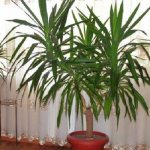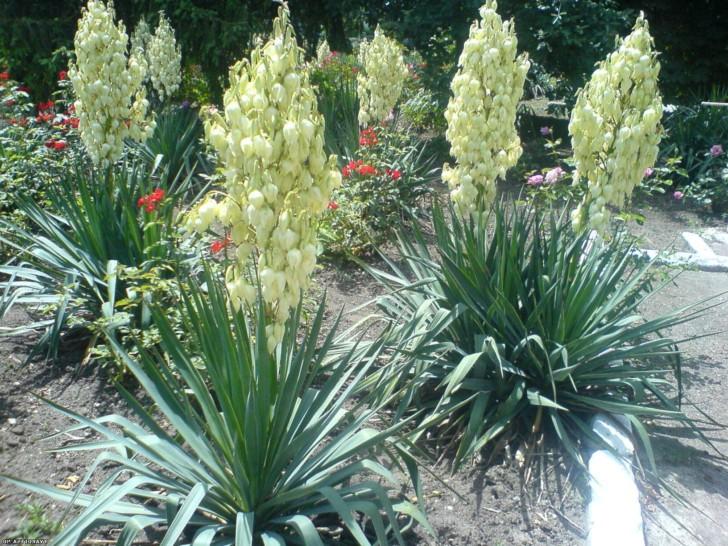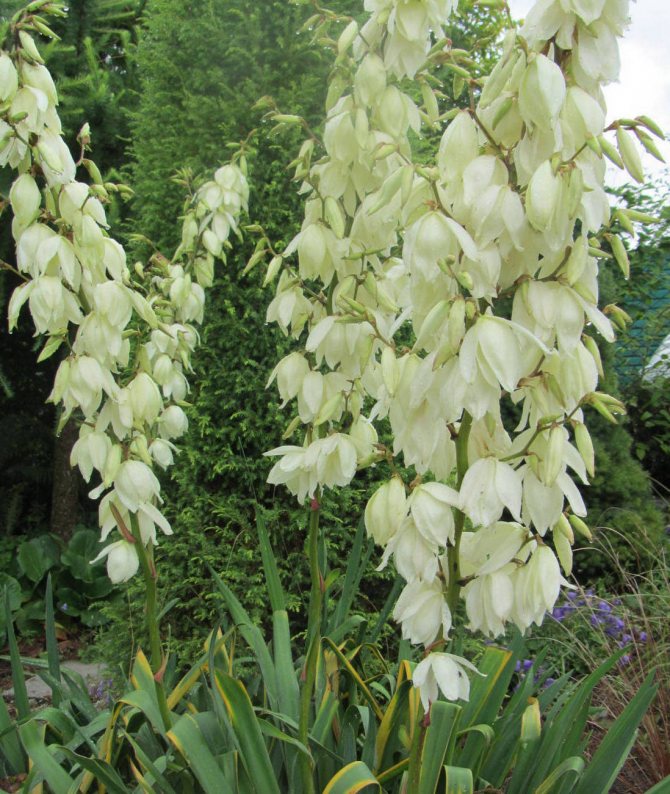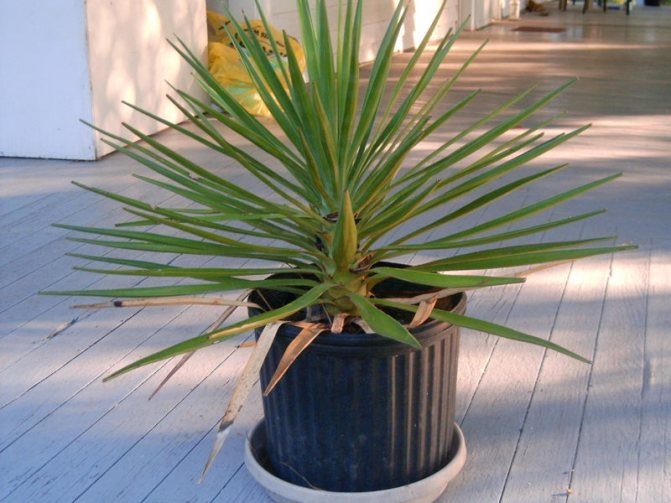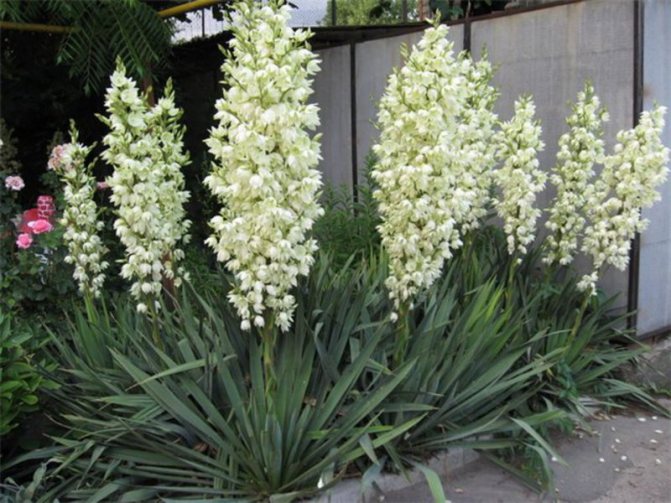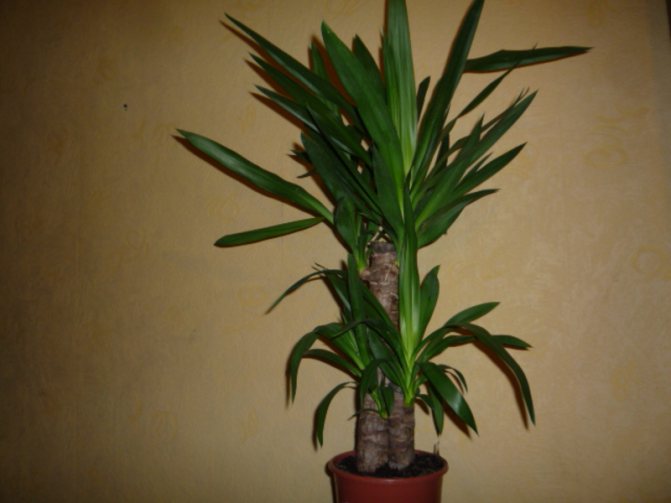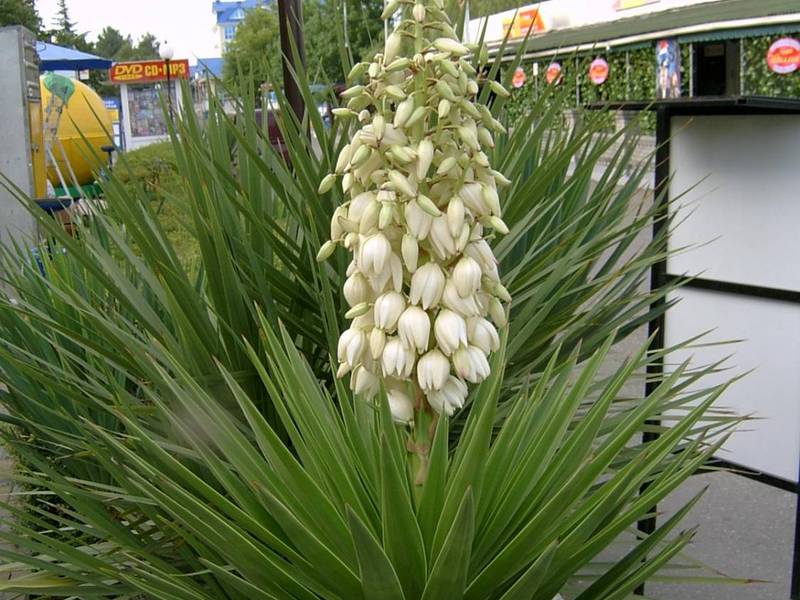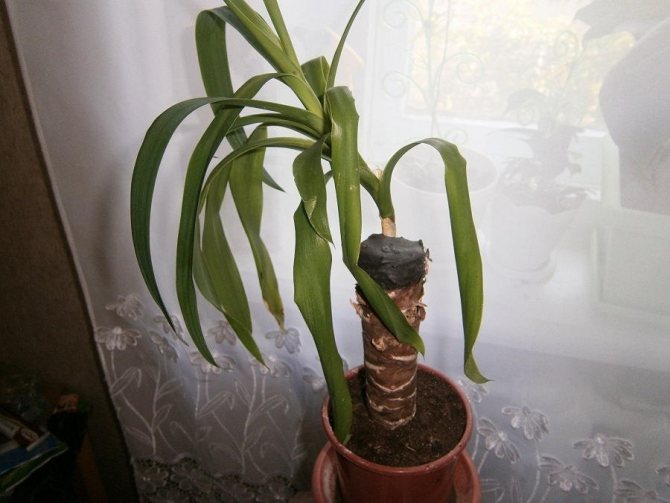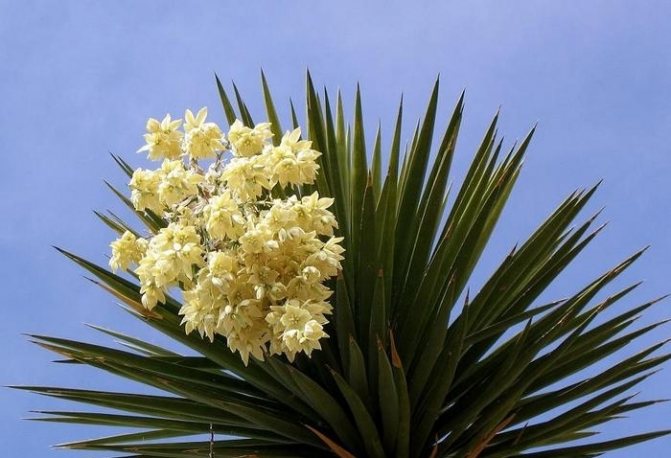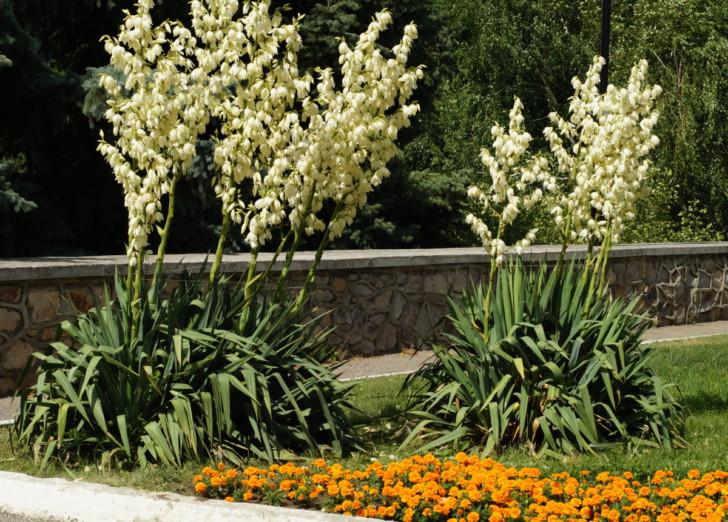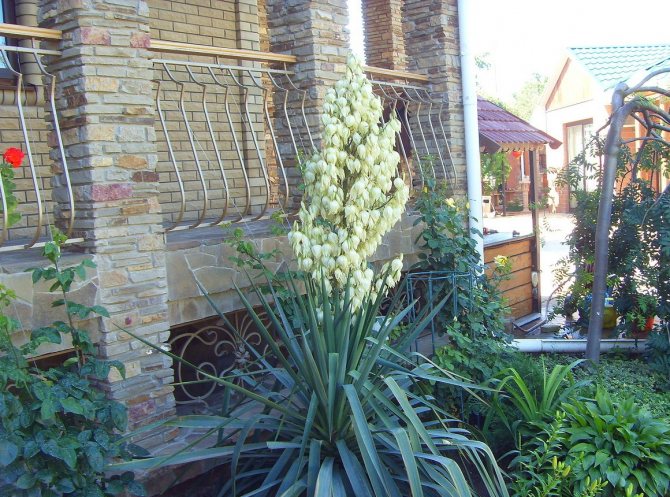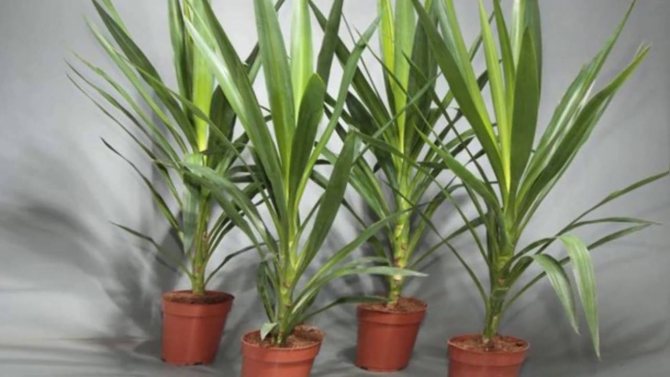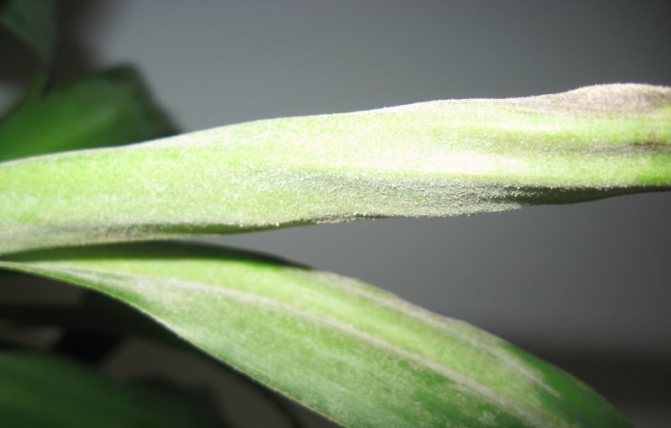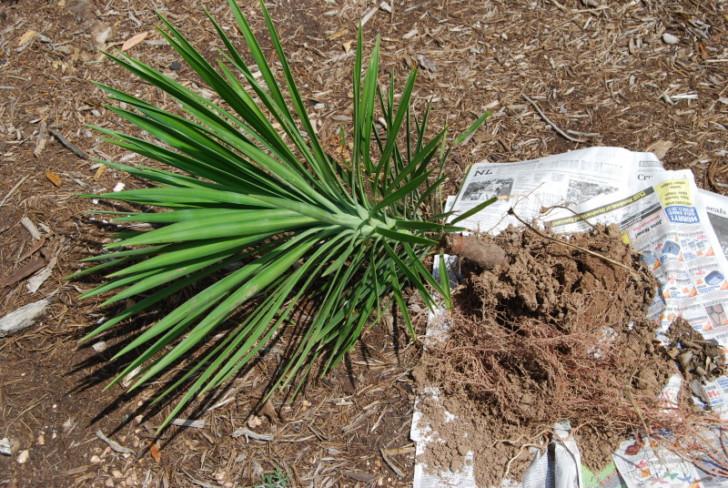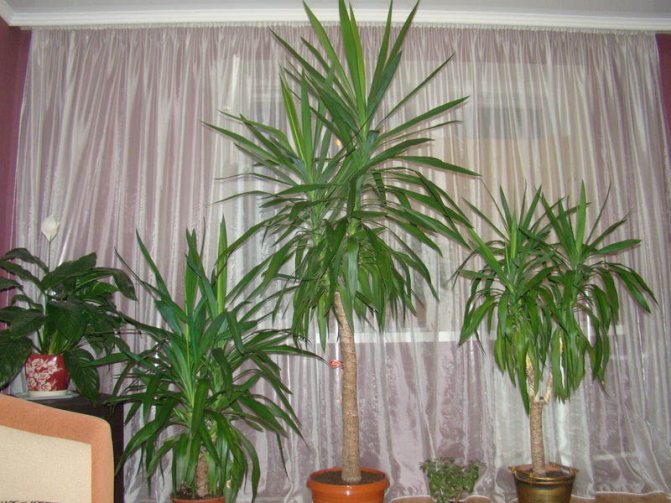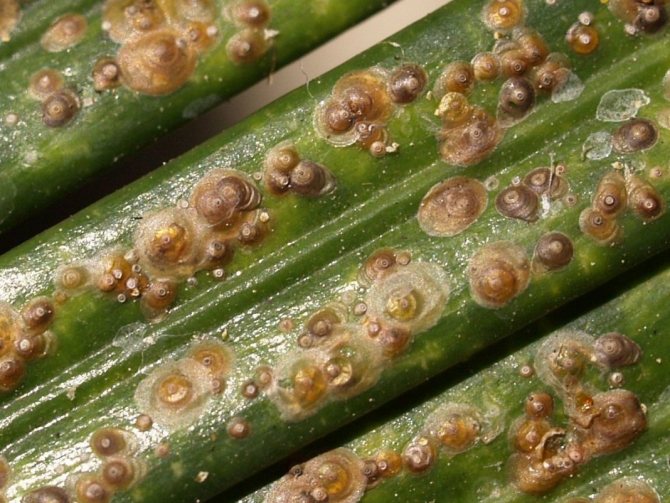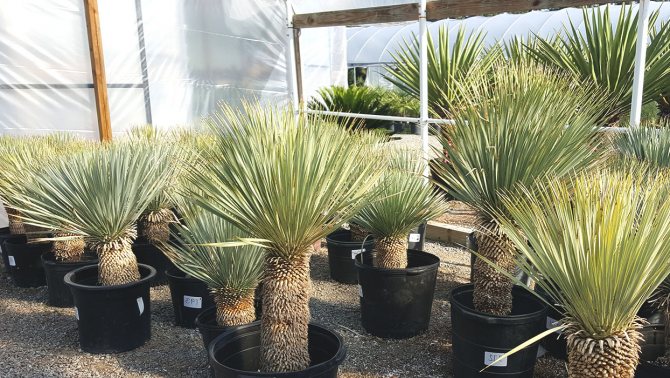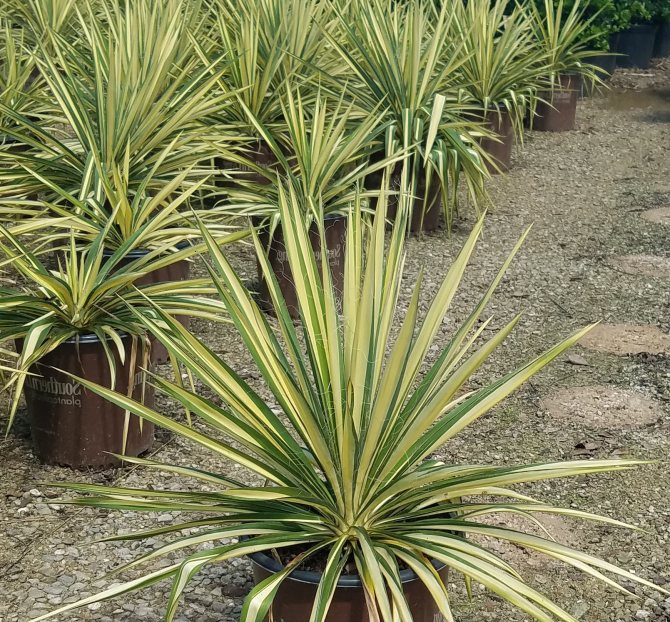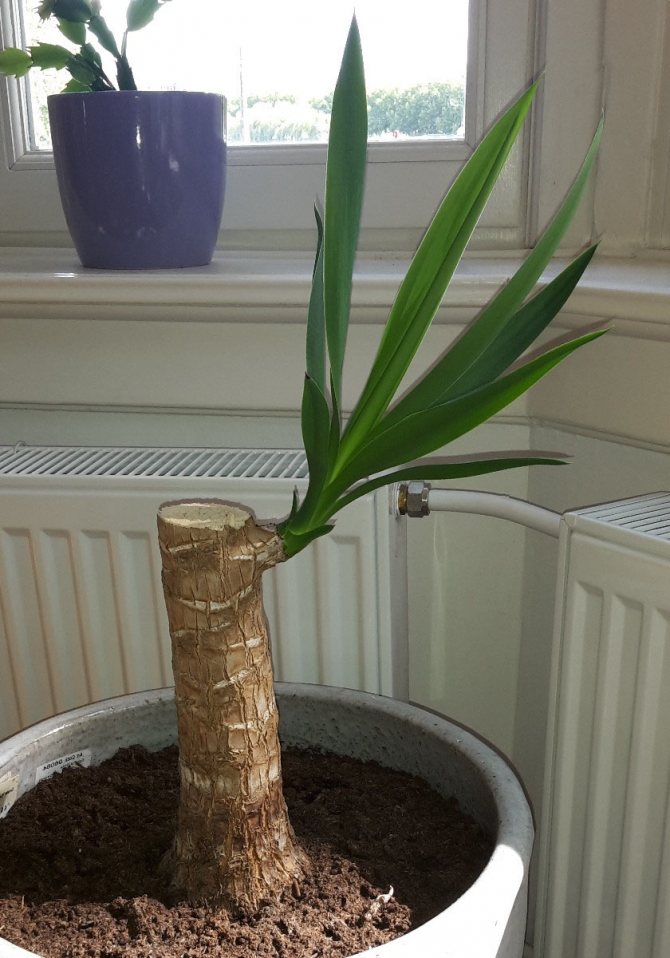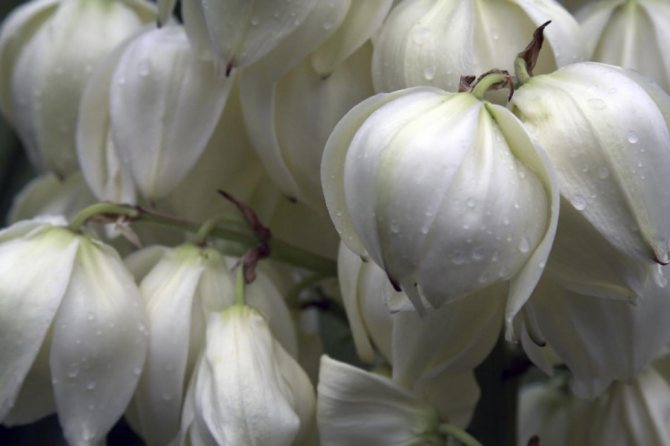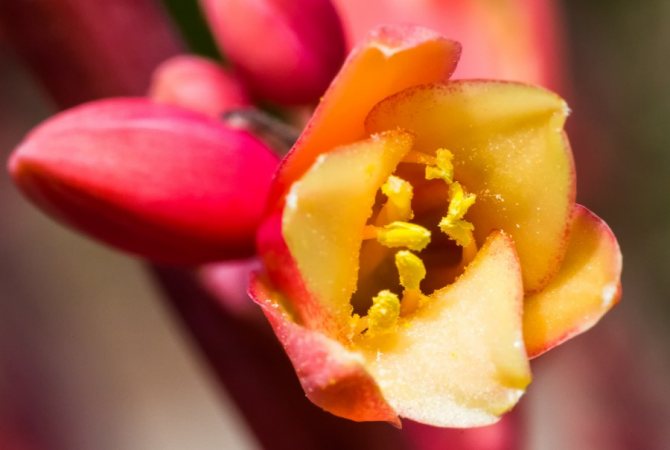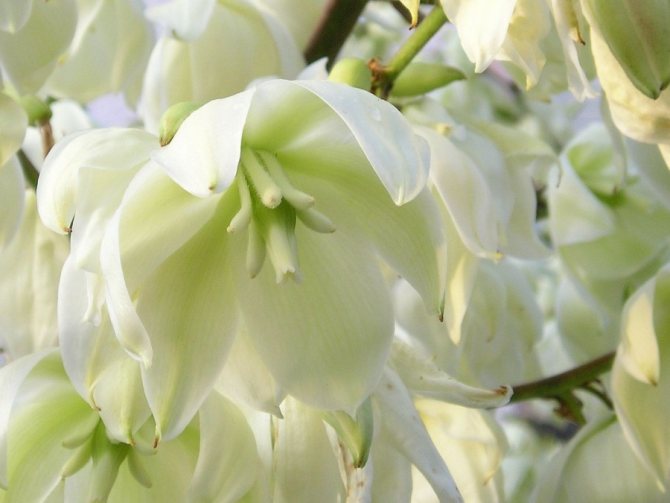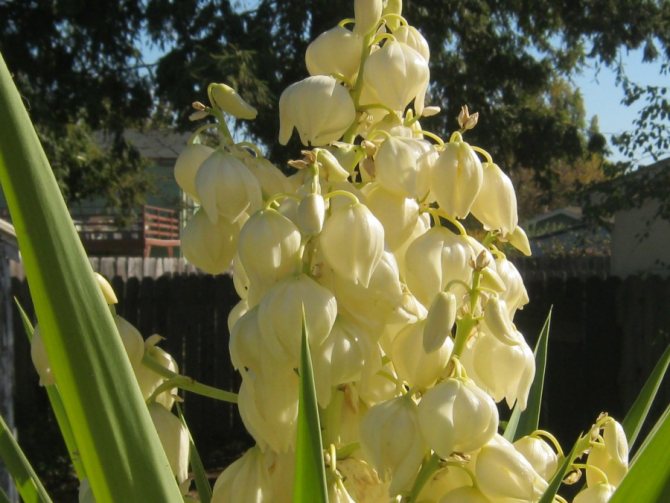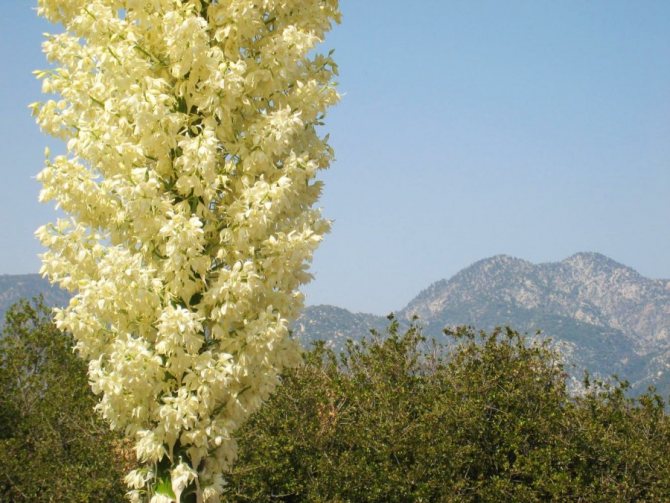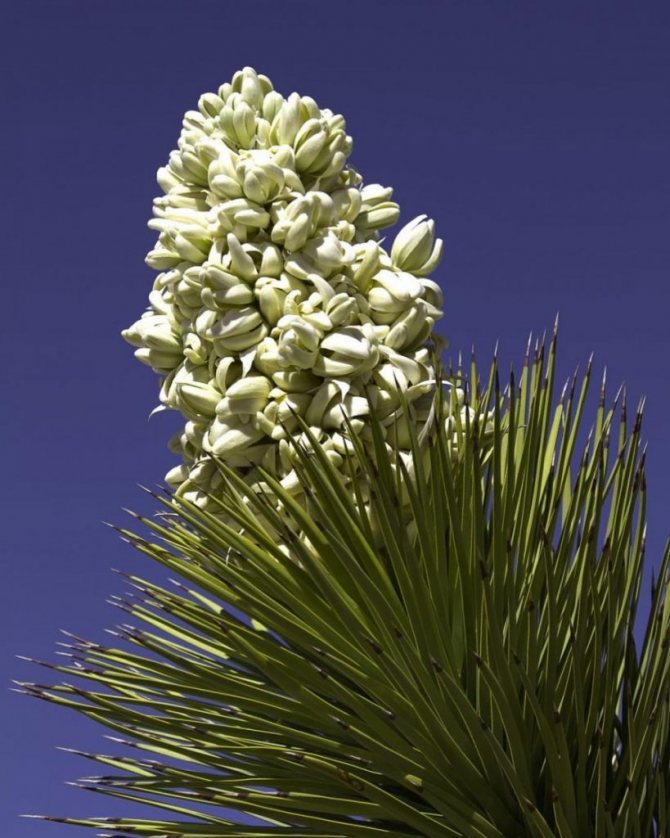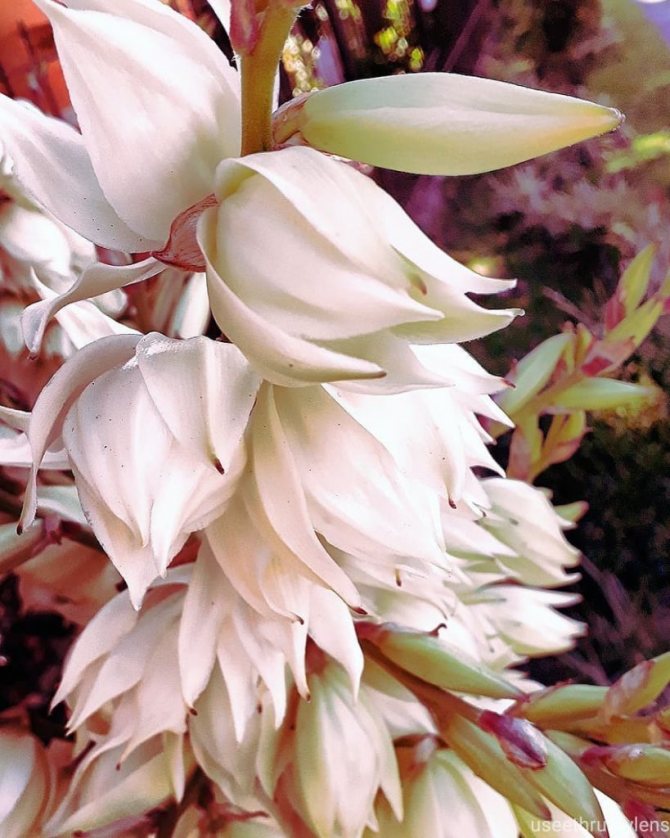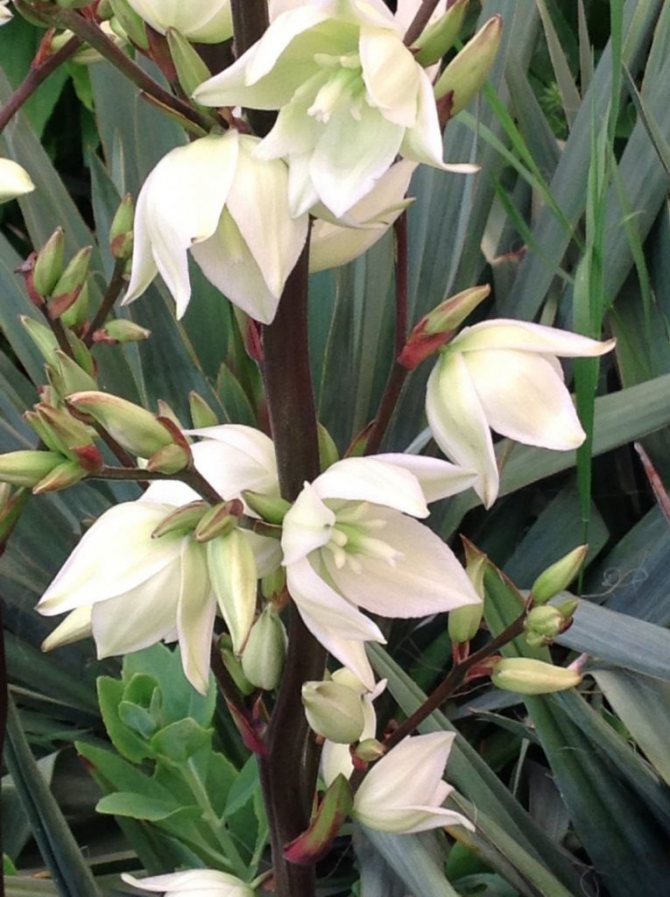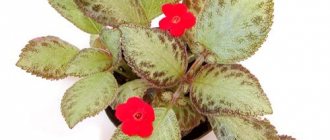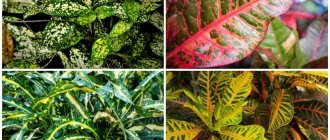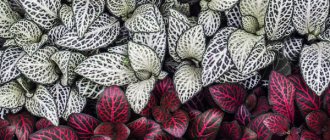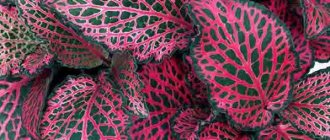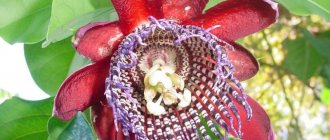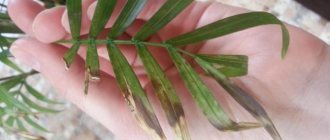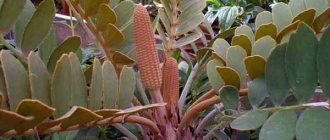The shape of the leaves is xiphoid, long (up to 50 cm), pointed towards the end. The color of yucca leaves, depending on the type, is green, gray or green with a bright yellow, white stripe. Along the edge, the leaf plates are covered with hard fibers. The homeland of yucca is Central America, or rather its arid regions and Mexico. At home, yucca is grown for decorative purposes as a deciduous plant and rarely blooms.
| Low growth rate, up to 30 cm in one season. The trunk of Yucca elephant does not grow after pruning, only rosettes grow. |
| It does not bloom in indoor conditions. |
| The plant is easy to grow. |
| Perennial. |
Description and characteristics of culture
The description of indoor yucca allows you to highlight its characteristic features and not be confused with other similar plants. A correctly drawn up characteristic makes it possible to recognize a noble flower and allocate an honorable place for it in your home.
External description
The height of indoor yucca reaches 2 meters. The plant has a lignified stem, which looks like an elephant's leg, at the top covered with leaves of green or bluish color. Yucca foliage sticks out in different directions, drooping a little. Its shape is xiphoid. Each leaf is capable of growing up to 0.5 meters in length. There are varieties in which the trunk is completely absent, and the crown is 1 or more sockets.
Root system
The weak spot of indoor yucca is its root system. Although the flower itself is large, its roots are small. In too dense soil, they suffocate, and with an excess of moisture they rot, and the plant dies.

All about blooming
Not all plant owners can admire the flowering of homemade yucca. Some species in captivity categorically refuse to throw out the peduncle, even with proper care and maintenance.
First bloom
Yucca blooms for the first time only in the 7-10th year of life. Under indoor conditions, this process can be delayed, or the plant does not form a flower bud at all.
How often does yucca bloom?
The flowering frequency of a yucca is directly dependent on the cultivated variety. In most cases, it forms a kidney once a year.


general information
Yucca is a genus that includes tree-like evergreens from the agave family. There was some confusion with their classification, because they were originally included in the subfamily Dracene family of Liliaceae. Today, yuccas are representatives of the Asparagus family, although they were not excluded from the friendly subfamily of Dracaenaceae.
It is interesting! In the American language version of English, "yucca" sounds like "yakka".
Yucca is native to the arid regions of Central America. It is really very similar to a palm tree, especially in nature, where the lower foliage dries up and falls off, and the surface of the trunk becomes lignified.The crown of the yucca is decorated with a bunch of hard, large leaves.
The size of these large shrubs growing in nature is impressive, because their height can reach 8 m. The domestic yucca palm is a more compact plant - 1-2 meters in height, but even with such dimensions, it looks like a real giant against the background of other domestic vegetation. The length of the leaves of indoor yucca is 40-50 cm.
There are several types of stemless yucca, their crowns consist of one or more rosettes.
The flowering of Yucca is an impressive sight, the plants develop strong, upright peduncles covered with a large number of buds. The flowers are large, shaped like a bowl-shaped bell. Most often they have a white color, but there are species with creamy green, yellow or pink flowers.
The fruits of most yuccas are dried up capsules, although in some varieties they look like juicy fruits that can be eaten.
Unfortunately, homemade yuccas very rarely pamper their owners with flowering; this requires almost ideal conditions of detention and special care, which only experienced flower growers can do. But, on the other hand, these pseudo-palms are distinguished by their rapid growth and after a few years a small sprout turns into a luxurious bush or tree.


Growing conditions
To grow yucca in indoor conditions and wait for its flowering, it is necessary to create suitable conditions for this and follow the recommendations of experienced specialists.


Optimal location: lighting and location
Yucca belongs to light-loving cultures, therefore it is preferable to place it on a stand near the eastern or western windows. The room should have a sufficient level of illumination, uniform throughout the day. This factor has a significant impact not only on growth and development, but also on the decorative qualities of the flower.
It is not recommended to place the yucca on the floor, as in this case it will not receive additional light. The stand should be flush with the windowsill. If the plant is placed near the south window, then at noon it will be necessary to create additional protection from the scorching sun rays (blinds or curtains) in order to prevent sunburn..
A small young flower can be kept right on the windowsill. In summer, they will have to be protected from sunburn, and in winter, make sure that they do not touch the cold window. In winter, in any place, yucca suffers from a lack of lighting, therefore, it is imperative to organize illumination using a phytolamp or fluorescent lamp. Daylight hours for a plant should last up to 12 hours.
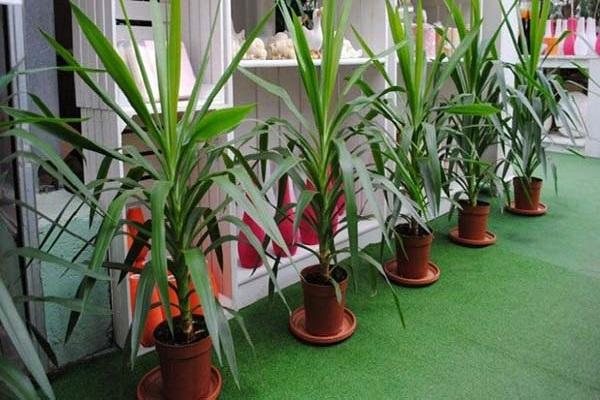

Temperature regime
Yucca is successfully grown at standard room temperature. An indicator of 22-26 ° C is considered optimal. In winter, it is preferable to reduce the temperature to 16-20 ° C. The plant does not like sudden changes, and also needs protection from hot air currents from the heating battery.
See also
Why do the leaves of rhododendron turn yellow and what to do for treatmentRead
Humidity
Yucca does not need high humidity. The standard indicator of a city apartment (40-50%) is sufficient for it. If the humidity drops below this limit, then the leaves of the plant are sprayed, and artificial air humidifiers are also installed.
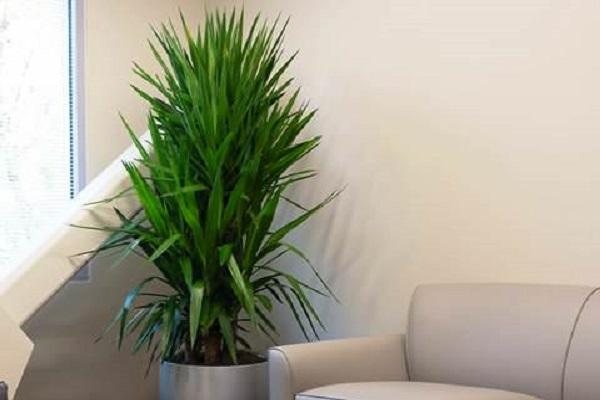

Substrate requirements
For planting yucca, you can buy ready-made soil in the store. Suitable substrate for growing palm trees, dracaena and yucca. It is also prepared independently, necessarily including the following components:
- sod land;
- rotted needles;
- coarse river sand;
- humus.
It is allowed to replace humus with purchased vermicompost, and add peat to the leaf part.An adult yucca needs a denser soil, because it contains half of the sod soil. A drainage layer must be laid on the bottom of the pot, and only then is the nutrient soil for the plant filled up.
Pot volume and dimensions
Planting a yucca requires a deep pot that is spacious in width. The root system should be placed freely in the container, and a distance of 1.5 cm is left to the walls.
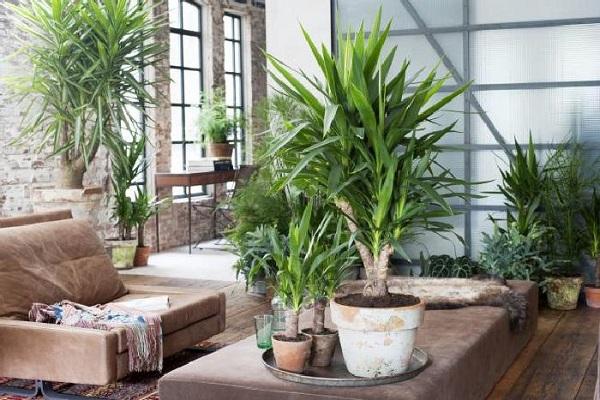

About diseases and pests of yucca
This false palm has very good health, however, mistakes in care can shake it:
- Use for irrigation with cold, unstable water.
- Being in drafts.
- Excessive waterlogging and hypothermia of the soil.
- Damage to the root system.
Finding a plant in a cool and waterlogged soil often leads to decay of the rhizome. The first symptoms of violations are lethargy and further foliage. You can save your pet if you take emergency measures with the initial symptoms:
- remove the flower from the ground;
- inspect and cut off rotten roots;
- the rhizome is treated with a disinfectant;
- a flower dried up in the open air is planted in fresh soil.
Weakened by poor care, diseases and unsuitable conditions, specimens are often attacked by parasites: mealybug, aphids, spider mites, scale insects. You can remove them with the help of insecticidal preparations - Aktara, Karbofos. The plant is preliminarily treated with a solution consisting of shavings of laundry soap and water.
An exotic pet owner should be alarmed if the following signs are present:
- The tips of the foliage take on a brownish tint - the flower suffers from a draft or too dry air. The soil may be dry and watering is required.
- The appearance of light spots is sunburn.
- Twisting the leaves - the yucca is frozen.
- The leaves are covered with brown spots with a yellowish border - a symptom of the fungal disease anthracnose. The main reason is high humidity, it is treated with an antifungal agent.
- The formation of a whitish bloom - perhaps the palm is suffering from powdery mildew. The disease is fungal, the use of fungicides is required.
To avoid trouble, it is advisable to take care of the plant by providing suitable conditions and care. Preventive measures like these will keep the green pet healthy.
Planting scheme and technology
Planting a yucca on your own is not so difficult, it is important to get high-quality planting material. There are several methods for propagating a decorative flower, in which each action taken is described step by step. It should be noted that until complete rooting, the soil should be kept moderately moist. When overdried, the seedling will dry out, and with waterlogging, there is a high risk of decay.
Pots with unrooted yuccas are placed in a warm room. It will be advisable to arrange heating of the lower part of the container. A plastic bag or a piece of plastic bottle is put on top of the plant to achieve the effect of a greenhouse. A month after planting, the root system begins to form, and after a couple of months new shoots break through, signaling the need for a flower transplant.
How to act from the moment the yucca appears at home
The primary requirement when purchasing a plant such as a yucca home is to organize the conditions for proper acclimatization, since changing conditions of detention are a significant stress factor for him:
- Transfer.
After purchasing, you should pick up a pot of larger volume - the height of the wall plays an important role, since the plant needs a large amount of drainage, at least 5 cm.
- Priming.
The land in which the yucca grew before its acquisition is recommended to be completely replaced - it can be a ready-made soil mixture or a self-prepared composition with a neutral acidic environment.
- Planting depth.
When determining the level of planting, one should be guided by the immersion of the stem - when the stem part is covered by more than 3 cm, there is a risk of rotting.


For reference!
Preparing a soil composition for yucca at home will require mixing humus, sand and sod land in 1/2/2 proportions. At the same time, the sand is selected for a large fraction.
Plant care at home
Yucca is an unpretentious flower, but it requires a little attention and care. In gratitude, the plant will delight you with decorative qualities, and possibly even flowering.


Irrigation system
Watering the yucca is permissible only with settled water at room temperature in order to avoid acidification of the soil. The frequency of irrigation is directly related to the size and age of the plant. The larger it is, the less often you will need to water it. The volume of the pot also plays an important role. The soil dries out faster in a 5 liter container than in a 20 liter container.
In summer, yucca grows actively, therefore it needs more liquid than in winter. The need for watering is determined by the state of the upper soil layer. The earthen coma should not be allowed to dry out strongly, but excess moisture also negatively affects the health of the flower..
Top dressing and fertilization
You can feed the yucca with one of the drugs offered in the store. The modern assortment allows you to choose both complex mineral and organic fertilizers that are suitable for this particular type of plant. The recommendations and dosages specified by the manufacturer should be strictly adhered to. Otherwise, instead of the expected positive result, significant harm can be caused to the flower. It is also taken into account that in the fall the amount of dressings decreases, since the yucca prepares for the dormant period and consumes less nutrients from the soil.
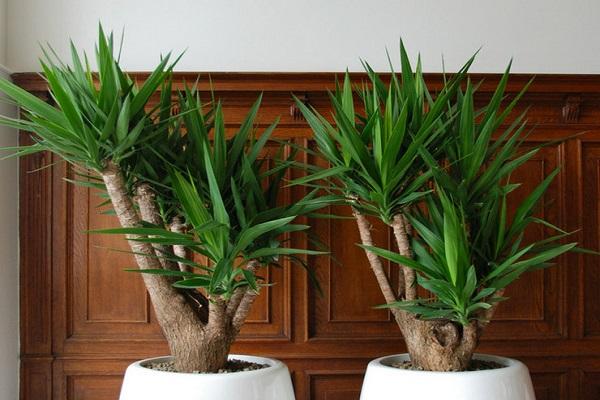

Formative pruning
Trimming the yucca is required in order for it to have a beautiful shape. Otherwise, the plant will have one elongated trunk with a bunch of leaves at the end. Also, using this procedure, you can rejuvenate an outdated tree. The first pruning is carried out at a time when the height of the trunk reaches 65 cm, and its diameter is 5 cm. It is preferable to carry out the work in the spring, after watering the flower.
When pruning, the top of the yucca is removed and the trunk is left 45 cm high.When the cut point dries up a little, it is treated with garden varnish or sprinkled with activated carbon. Several axillary buds are then activated. Only those of them are left that will form the necessary branches, the rest are used for reproduction.
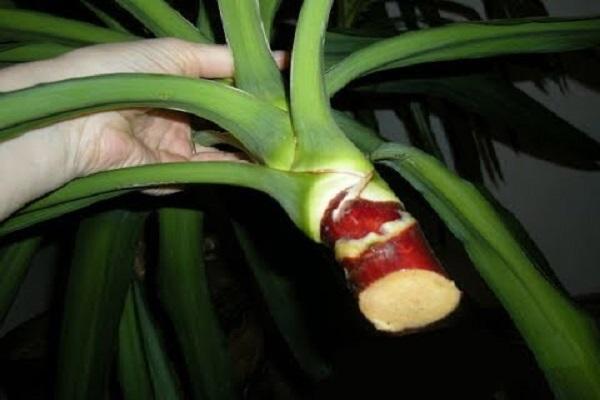

Transfer
Immediately after purchase, the yucca will need to be transplanted. Also, this procedure is carried out with:
- suspicion of a disease of the root system;
- every 2-3 years, increasing the volume of the pot.
The transplant is carried out in the spring, having previously prepared a larger vessel, soil mixture and drainage. A few days before the planned work, they stop watering the yucca. If the soil in the pot is still good, then only the top layer is removed.
See also
Description of varieties of catharanthus, reproduction, cultivation and care in the open fieldRead
Before direct transplantation, a thorough examination of the state of the root system is carried out. If there are soft and darkened areas, they are immediately cut off, and the wounds are treated with activated carbon powder.
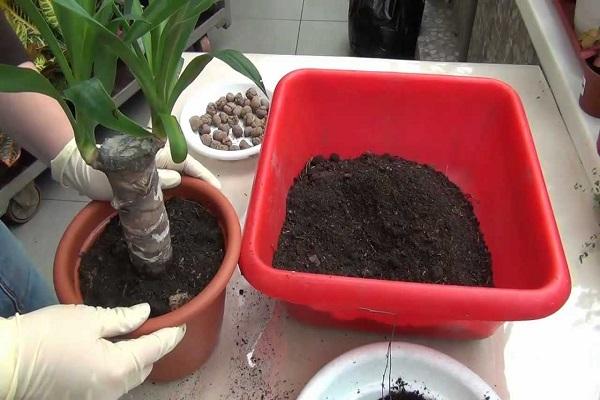

How to care for leaves, dust removal
Leaves are the main decorative element of yucca, therefore their condition is very important. Over time, dust accumulates on them, which not only spoils the appearance, but also negatively affects the health of the flower.Some people prefer to send a green pet to the shower, washing away all unnecessary from it, but it will be correct to regularly wipe the leaves with a damp cloth. After the shower, the plant should be allowed to dry in a place protected from light, and it is better to carry out the procedure in the evening.
Types of homemade yucca with photos and names
Yucca elephant
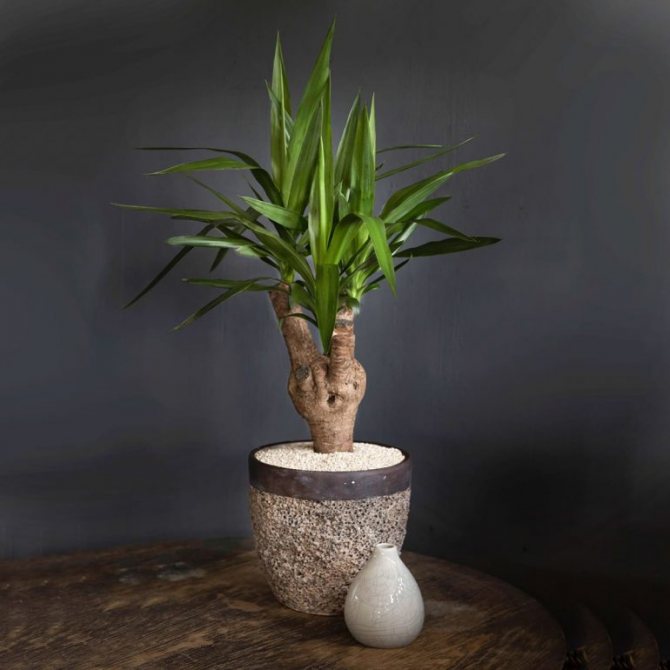

More often than other species found in home floriculture. The name of the species was given by the shape of the trunk, resembling the leg of an elephant. Yucca elephant grows more slowly than other species, but it also has fewer claims to the conditions of detention. The lower part of the trunk is usually without leaves, the upper part branches into several shoots, densely overgrown with rosettes of long, pointed at the top, dark green leaves. Young leaves of a xiphoid shape stretch upward, with age, droop to the bottom and dry out on the trunk.
Aloe leaf yucca
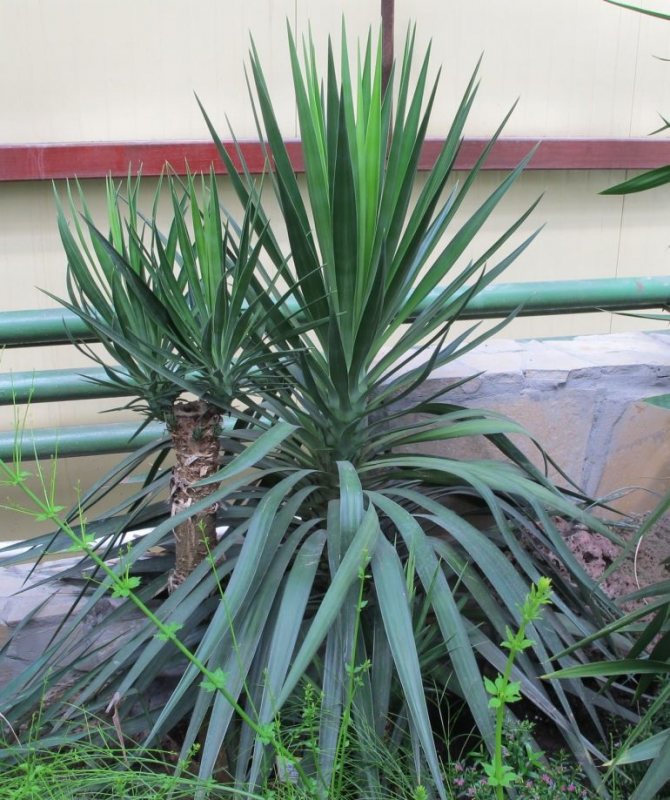

On a dense, pronounced trunk, a dense rosette of xiphoid leaves is formed in a spiral, wide at the base (up to 15 cm) and strongly pointed at the end. The dark green color of the leaves is covered with a bluish bloom. The edge of the leaf blade is serrate, lighter. The plant practically does not bush, but can produce an attractive peduncle with large, creamy white bell-shaped flowers.
Yucca Whippla
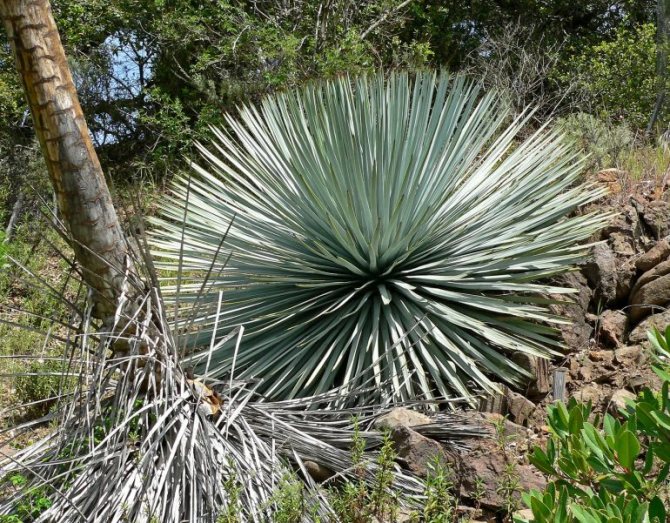

It is a spherical bush, consisting of a volumetric rosette (up to 1m in diameter) of long, fibrous leaves and a short, dense stem. The lanceolate leaf blade, serrated at the edges, is pumped in with a sharp thorn. The color is dull, gray-green. The rosette can give one high peduncle, but after flowering, its aerial part dies off, and in its place, young shoots grow.
Short-leaved yucca
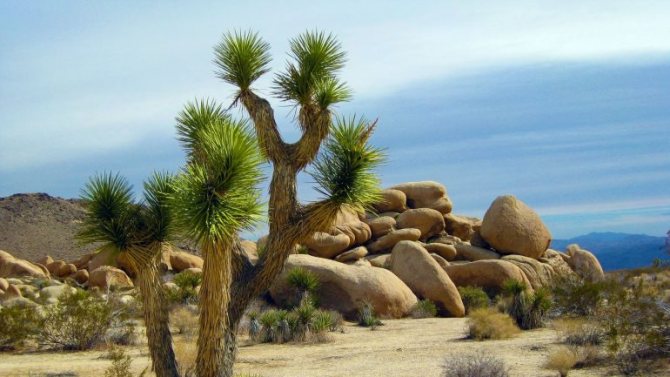

It is a type of large, garden yucca native to the southern states of America. It grows slowly as a tree with a thick trunk, in nature it can reach a height of 10-15m. Intense tillering begins at the top of the trunk. Short (up to 30cm) leaves in the form of an elongated triangle are attached with the base to the lateral shoots and form a rosette. The edges of the leaf plate are decorated with a small denticle and thorns. In a residential environment, keeping such a plant is problematic.
Diseases and their treatment
Like any indoor flower, yucca is susceptible to pests and various diseases, which greatly impair the decorative properties and can even lead to the death of the flower.
Foliage
Curled leaves often signal low temperatures and lack of lighting during the resting period. It is necessary to take care of the normalization of these indicators by installing phytolamps.


Leaf spot
This sign indicates the presence of fungal diseases provoked by excessive moisture. It is necessary to reduce the number of waterings, reduce the level of humidity in the room, and remove and destroy the affected parts of the yucca.
Dry spots on the leaves
An alarm indicates an excess of light and insufficient humidity. It is recommended to move the pot to partial shade and increase the humidity level.
Rot
Root decay is most often caused by excess moisture and stagnant water in the pan. It is urgent to transplant the plant, removing all affected parts and treating it with activated carbon, a weak solution of potassium permanganate.
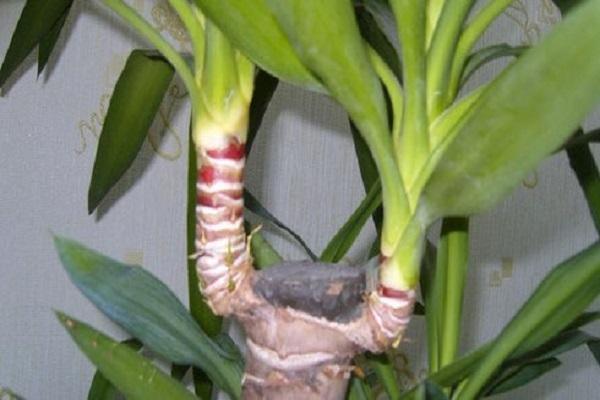

Useful properties of yucca
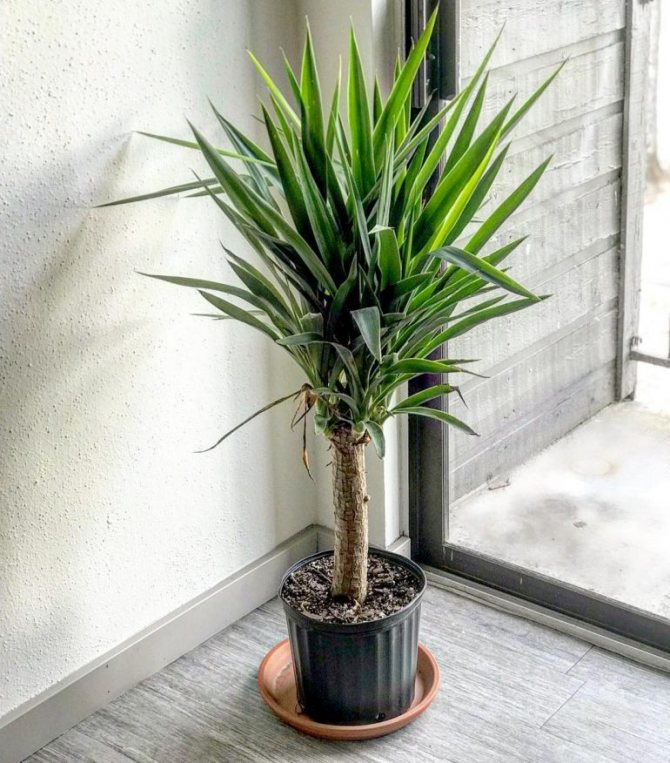

Yucca elephant room. Photo
Naturally grown yucca fibers are used for technical purposes to add durability to denim. As a biologically active additive it is used in cosmetology. In folk medicine, healing and bactericidal properties are used.
Indoor plant species create a coziness, a serene atmosphere, help purify the air and absorb noise. It is believed that peace and prosperity reign in the house where the yucca grows. In office buildings, a mysterious flower is grown for business success.
Fight pests
Houseplant pests are no less dangerous than disease pathogens. We must fight them decisively and in a timely manner.
Spider mite
The pest acts on the underside of the leaf plate, as a result of which it becomes dull, and eventually dies off altogether. Effective prophylaxis is spraying green mass with soapy water and insecticidal agents.
False shield
The false shield acts not only on the leaves, but also on the stems of the yucca. If the pest is not destroyed in a timely manner, the flower may die. To combat it, a solution of the drug "Actellik" is used, which is used to wipe the sheet plates.
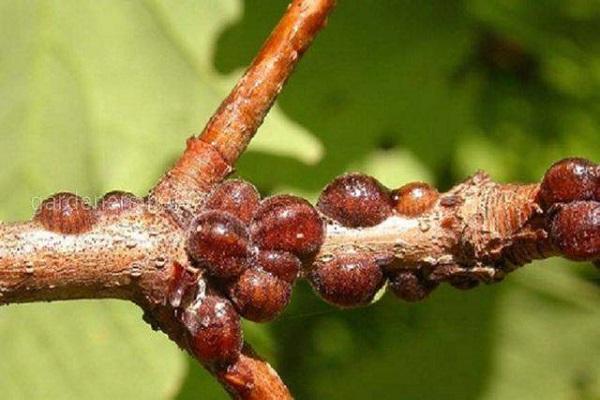

Generalized description of the plant
The stem of the yucca has a tree-like structure and, depending on the type of plant, it will burn to be single or branched.
The leaves are large and are located on the bush in bunches, while they can be either completely smooth along their own edge, or covered with thorns.


During the flowering period, large inflorescences are formed on the branches, consisting of cup-shaped buds.
The size of each of the flowers is quite large, but at home, flowers are rare for yucca.
The fruits that form on the plant are in the form of a dry box, which is of no interest except for certain species with edible fruits.
Reproduction of culture
There are several effective and simple ways to propagate room yucca, which are used by flower growers.
Plant propagation
Reproduction of a false palm tree by cuttings is carried out mainly in the spring, but this method is practiced until August. To obtain planting material, it is recommended to divide the stem of the plant into 10 cm pieces each. A stalk from the top is planted in a nutrient mixture and a greenhouse is formed on top of it. The rest of the cuttings are placed horizontally in the soil and buried a little. After a while, the dormant buds will awaken and form new shoots. When they grow a little, young yuccas can be planted in separate pots.


Sowing with seeds
Seeds are sown in nutrient soil, a sheet of glass is placed on top or covered with transparent film to organize a mini-greenhouse. The humidity in it is maintained at a level of 75%, daily ventilation is organized, and, if necessary, the soil is sprayed from a spray bottle. A month later, the first shoots of yucca are shown. As soon as they grow up, each seedling is planted in a separate container.
Tops
Yucca can be propagated using any broken twig or cut off top with a rosette of leaves. If it is long, then the trunk is slightly shortened and allowed to dry for a couple of hours, and then the lower leaves are removed. The resulting stalk is planted in a nutrient soil and covered with cellophane or a glass jar. The soil should be kept slightly moist.
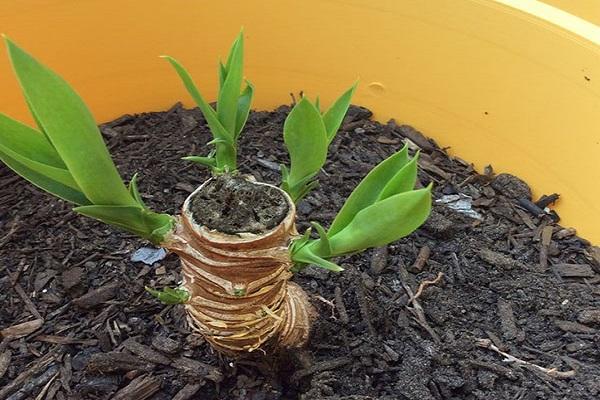

The stem trimmings can be placed in water for rooting. To avoid decay, activated carbon and ash are added there. As soon as the roots are formed, the yucca is planted in a separate prepared pot. The method of reproduction in segments makes it possible to save a flower that, for various reasons, has lost its root system.
Care features
Due to the fact that yucca is a rather thermophilic plant and completely unusual for Eurasian conditions, the first question is the rules of care.
However, even a beginner in crop production can handle everything required.
Under natural conditions, summer temperatures are around 26 ° C, and in winter around 20 ° C. Approximately such indicators should surround this exotic.
Attention!
According to some experts - in winter, you can give the plant rest, providing it with a temperature in the range of 10-15 ° C
Lighting
Young yucca is demanding in terms of lighting, therefore it is recommended to place the pot in a room with such support.


However, it is not recommended to put the plant on the windowsill - direct exposure to sunlight can negatively affect the condition.
In the summer season, exotic should be placed in the fresh air, for which a balcony or an open terrace is suitable.
In this case, one should take into account the susceptibility of yucca to drafts and the need for shading from the sun.
Reference! Some experts point out that the flowering of yucca is inhibited in the conditions of an apartment precisely because of the lack of lighting.
The best option for setting a pot with this exotic is a table located by the window at the level of the window sill, which will not only provide the necessary amount of light, but also eliminate the risks of damage to the plant by direct sunlight.
Humidity


The normal development of such an exotic as yucca is also important humidity, which corresponds to its natural habitat conditions.
In an apartment environment, the recommended humidity level should be 40%.
To ensure the norm, you can use various methods:
- household air humidifier;
- spraying from a spray bottle;
- shower for yucca (no more than 1 time per month).
These options will provide the exotic with the necessary climatic environment and clean the leaves from dust.
Watering features
Due to the fact that this "palm" is accustomed to drought conditions, watering is primarily dependent on such individual factors:
- the size of the pot;
- exotic age;
- the height of the yucca itself.
For example, a young plant should be watered daily with small volumes of water, and for an adult, the volume of soil is calculated and taken as an indicator for the displacement in direct correspondence - 1 liter of land requires 1 liter of water with watering once every 2-3 weeks.
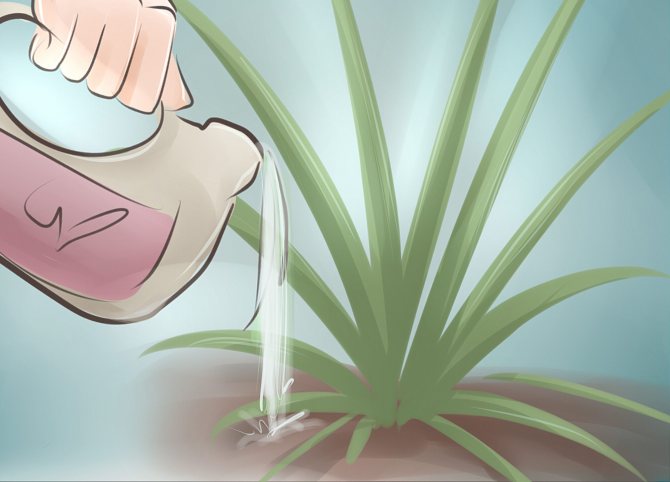

When it comes to watering, the season should also be taken into account - if in the summer the best option is to water more often up to 1 time per week, then with the onset of the cold period (on average 18 ° C), it is recommended to water the yucca no more than 1 time per month.
Also, before making a decision on watering, you should check the condition of the soil - an indicator of such a need for its dryness.
If the soil is still moist enough, you should postpone watering for a few days.
Additional rules for watering include:
- Mandatory emptying of the pallet - excess moisture near the root system of the "palm" can lead to its decay.
- If the upper layers of the soil do not dry out in the first days after watering, it is necessary to loosen the soil, since it is excessively compacted and the root system will not receive the required recharge.
- During periods of using humidifying techniques, you should also be careful about drying out the soil - watering should be done less often than usual.
Yucca feeding
Yucca does not require any special soil fertilizing compounds, it is enough to use classic liquid products intended for palm and dracaena crops.
Fertilizer should be added to watering in the spring-summer period, starting in April, and in winter it is better to completely abandon the "palm" feeding.
Attention!
If the yucca has been recently transplanted onto a soil specialized for dracaena or palm plants, or it has just moved to a new house for 1 year, you should completely abandon the use of fertilizers.
Transplant and its features
In addition to the classic norms for caring for yucca, it is necessary to take into account the importance of timely plant transplantation.
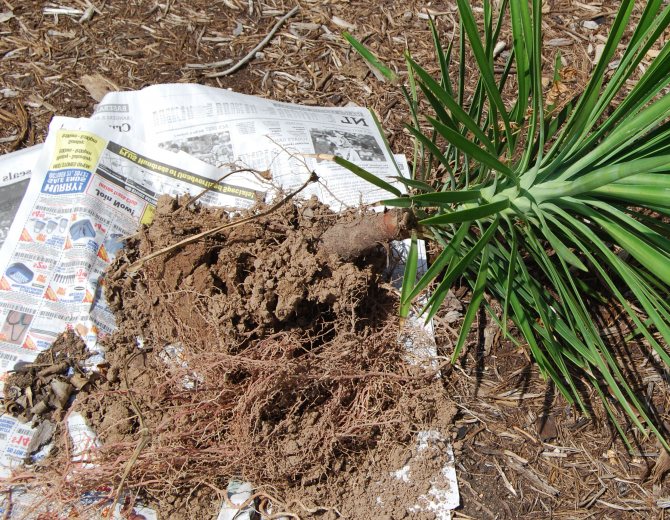

This procedure is recommended to be carried out no more than once a year, replacing the pot with a more voluminous one and adding the amount of soil in accordance with the new container.
The main rules for yucca transplant are:
- neatness with the root system;
- drainage level at least 5 cm;
- complete preservation of the earthen coma;
- the use of an already used soil composition.
Important!
If the roots are damaged, the plant will take too long to adapt to new conditions and may rot.
Pruning
The main direction of pruning in the case of this exotic is the rejuvenation of the plant and giving its crown a more aesthetic appearance.
A particular case of pruning is the reduction in height.
From the rules for this process, the following should be distinguished:
- The procedure should be carried out in the spring - the plant temporarily suspends its own development.
- The tool for pruning is treated with a disinfecting compound, more often with alcohol solutions or pure alcohol.
- In the process of cutting the leaves, you cannot break them off - the cut is brought to the end and the accuracy is monitored in relation to the points of growth.
- Places of cuts must be processed with crushed charcoal, which avoids rotting at these points.
Further plant care is fully consistent with the classic.
Important!
The trimmed parts of the yucca should not be thrown away, as they are used to propagate the shrub by grafting.
When to transplant garden yucca
If a plant grows in comfortable conditions for it and with the same good care, then it can perfectly live in one place, without requiring a transplant, for up to 20 years. And a plant transplant may be required only when the bush has grown excessively. This is especially painless for the plant if the age of the specimen has not yet reached three years.
Filamentous yucca transplant video:
But even an adult, highly overgrown plant needs a transplant. Plants often cannot be transplanted.
Experts give some advice when transplanting this plant, because you need to take into account some of the planting features.
- The transplant period is spring or late summer.
- When transplanting, remember that the roots of a plant can be located at a depth of 80 cm, so you need to dig it out carefully, without damaging the root system.
- All shoots must be separated from the adult specimen and planted separately.
- The place, which is intended for transplantation, according to the conditions, should resemble the previous one, have good illumination, without drafts.
- The first feeding after transplantation is best done no earlier than two weeks.
Open ground varieties
There are more than 30 types of yucca in nature, but only a few of them are used for outdoor cultivation.
Yucca Filamentous


The plant is common in the east and southeast of the United States. This species got its name due to the thin fibers hanging from the leaves. The species withstands low temperatures well. The color of the leaf rosette has two options - gray-green with a yellow border and yellowish with bright green edges.
Yucca the Glorious (or Spanish Dagger)
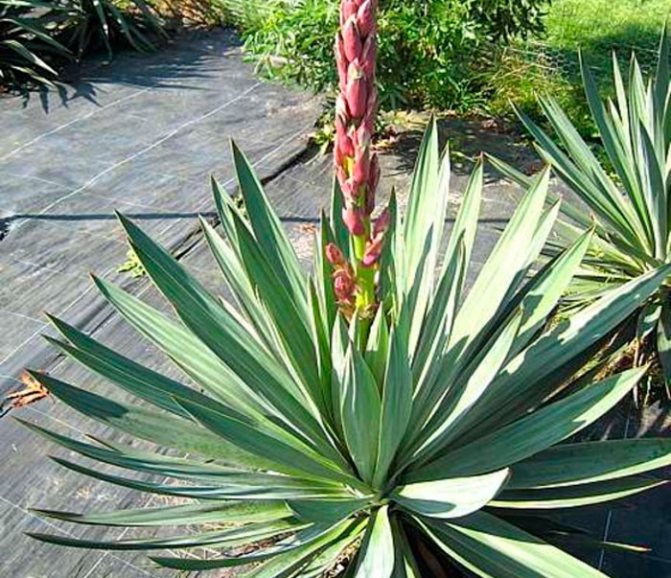

In nature - a shrub up to 6 meters high, in cultivation - no more than 2 meters. The leaves of this species are covered with small teeth along the edge, therefore they look like a saw.
Yucca Sizaya


Stemless shrub with narrow leaves about 70 cm long and decorated with curled fibers along the edge. A distinctive detail of the species is a high, up to 3 meters peduncle. The buds are greenish or slightly yellowish.
Yucca flower, how to care if you have problems
Yucca, like all plants, can be attacked by pests or diseases.
The most common are slugs, whitefly, scale insects, aphids.
The latter easily falls on flowers, which quickly dry up and fall off. Wood ash in combination with a soapy solution will help in the fight not only against aphids, but also against other insects.
You need to take 0.250 wood ash, pour water (10 liters) and bring to a boil, adding 0.50 g of ordinary laundry soap (grated). When the resulting solution has completely cooled down, immediately process the affected leaves.
Possible problems
- Dry air and cold drafts contribute to the formation of unkempt brown leaf tips that spoil the look.
- Brown spots all over the leaf may indicate fungal infections caused by possible over-watering.
- Bright sunlight can affect the appearance of light, dry spots.
Care after buying a yucca
Immediately after purchase, the bush is placed in a separate place away from other plants. In a few days, the plant adapts to new conditions, it will become clear if it is sick. If all is well, after a couple of weeks, the pot is moved to the common windowsill. It is forbidden to put a young palm tree in a sunny place or in a draft.
The most important thing to do after purchase within a couple of days is to transplant the bush into a new permanent pot. This is due to the fact that the palm tree for sale is supplied in a temporary short-lived substrate. A young plant is watered daily after transplanting, but in small portions.
False Palm Pruning Process
Upon reaching the trunk of the yucca more than seven centimeters in diameter, it is clipped. This is done in order to form a crown of the correct shape on the palm tree. Do not forget that after the procedure is performed, the growth of the plant stops.
You need to cut as high as possible from the base of the trunk... The plant needs to be well-watered every three to four days. The cut part is placed in a moist rooting medium. Thanks to the pruning method, the owner forms the height of the plant he needs.


Appearance
Yucca leaves cannot boast of a bright color (although some varieties have leaves with yellow and white stripes), but they have a very effective shape: they can grow in a spiral, completely covering the tree trunk, or they can stick up and to the sides.
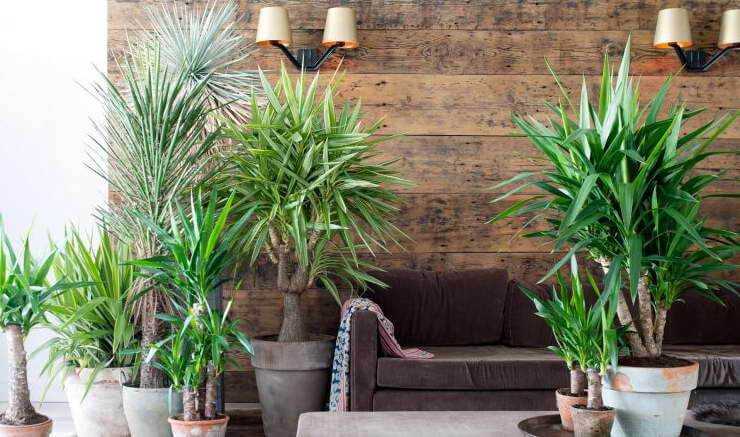

Yucca appearance
In the wild, it grows in tropical and subtropical zones. It has erect inflorescences, up to two meters long. They sprout from the very center and resemble panicles in shape.
Yucca is not one of those green favorites that are purchased for the sake of beautiful flowering. Although the flowers of the yucca resemble small bells, they can only be seen when the yucca is old enough. However, with indoor care, it is quite difficult to see yucca flowers.
Lighting
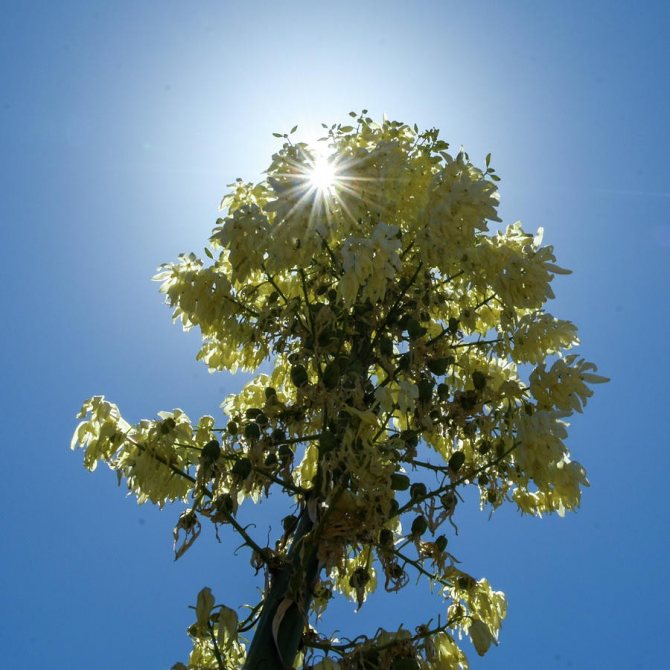

The natural habitat of the yucca is the sunny arid regions of central America. This fact is reflected in all domestic varieties and is expressed in the need for sufficient lighting. Indoor palms or yucca bushes should be located in well-lit parts of an apartment or house. It is recommended to place them near windows located on the south, southeast or southwest sides of the housing, where there is enough natural light during the day. In winter, it is extremely important to maintain artificial lighting, extending the light period to the summer norm.
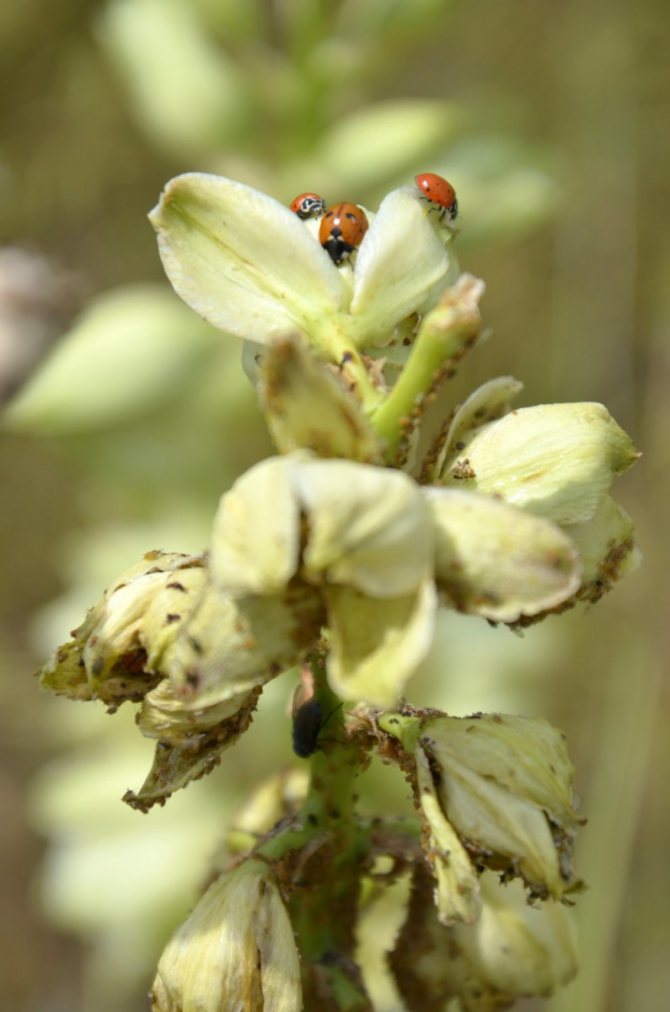

Particular attention should be paid to young plants. During the period of active growth, light for them is a vital element. However, the direct rays of the sun can harm exotic, especially if it is young. In active sundials, it is recommended to shade the light.
How to shelter for the winter
Is there a need to dig yucca before frost?
It is enough to insulate the plant before the cold season comes. Plants tolerate spring and autumn short-term cold quite easily. It is important that the fallen snow melts quickly. Such temporary inconveniences are especially easily perceived by frost-resistant specimens. But real long frosts with a snowless winter is a sure death for a garden yucca.
Yuki foliage is wrapped with twine to gather it together and the plant is covered with a box, on top of which spruce branches or fallen leaves are laid. Fixes such a composition with a covering material wrapped with tape. In such a shelter, the yucca will easily overwinter without fear of any frost, especially when a large layer of fluffy snow lies on top.
In the spring, when the temperature regime becomes stable, it is time to free the plant from its winter shelter. Do not delay with this for a long time, otherwise it may threaten the appearance of mold.
Temperature regime
The American evergreen shrub is excellent at room temperature.
He feels well in the temperature range from 15˚C to 26˚C.
A decrease in temperature will lead to hypothermia of the leaves and trunk, which will slow down growth or even lead to death. Too hot air will also negatively affect the palm tree and lead to its drying out and loss of turgor.
This green pet does not like drafts. When airing the room, it is better to move the pot where it will be protected from walking winds.

